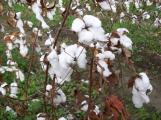1
The Coloured Corps in CanadaJames A. Black M.Ed
Agricultural Mass Production
Through the use of slaves, millions of pounds of cotton were planted, grown, and harvested with virtually no cost to American plantation owners. Like modern agricultural equipment today, slaves were initially expensive but were able to maintain themselves after their initial purchase. And, much like other machines of commerce, slaves were callously discarded or sold after they became non-productive.
3
Engraving of slaves working in cotton fields18th Century
No location applicable
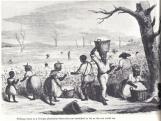 Credits:
Credits:A Pictorial History of African Americans from 1619 to the Present - 6th Ed; Hughes, Meltzer, Lincoln, Spencer; Crown Publishers, 1995
4
Emancipation in Canada 1973In 1793 Upper Canada was one of the first British controlled jurisdictions to introduce the emancipation of slaves. Canada's early military history offers some understanding of the struggle that brought about the end of slavery in both Canada and the United States. Refugees from American slavery not only sought their own freedom but willingly volunteered to fight for that same freedom for others in battles of: the early American Revolution, War of 1812, Fenian Raids, Rebellion of Upper Canada 1837-38, and WW I. The fight for freedom was not only faced on battle fronts - Blacks were forced to demand their right to even enlist.
5
Statue of Governor John Graves Simcoe, a well-known Mason22 June 2009
Niagara-on-the-Lake, Ontario, Canada
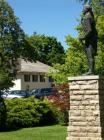 Credits:
Credits:James Black
6
Author's fingers beside 250 year-old fingerprints in homemade bricks, Boon Plantation, S Carolina11 November 2008
South Carolina, United States
 Credits:
Credits:James Black
7
Black Horse on carousel at Port Dalhousie, St Catharines, site of Emancipation Day Picnics20 July 2009
Port Dalhousie, Ontario, Canada
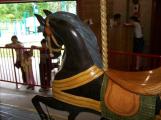 Credits:
Credits:James Black
8
Coloured Corps, circa 1776 - 1865A solider serving with the British Army expected to face death. That soldier also expected to: perform duties under horrendous battle conditions; fire weapons that could blow their hands off while loading; be shot for disobeying direct orders. If wounded with lead shot, death was often slow from infection or lead poisoning.
Many black soldiers had no families to return to having lost their families in their constant movement when being sold from one plantation to another. What made black soldiers different was not their abilities or their spirit to do battle but their place in history.
9
Artist depiction of Black Soldier Pioneer Field Engineer - no 'Living History' at Fort Mississauga20th Century
Unknown
 Credits:
Credits:Norval Johnson Heritage Centre
10
Giving up your PropertyAccording to "A Stolen Life," written by Meyler and Meyler, Loyalists and American Patriots during the War of Independence had to find replacements for those lost and wounded during battle. Giving up a worker - a slave - who the Loyalist or Patriot owned, meant the loss of valuable property. In spite of this concern the Royal Bateauxmen formed a transportation unit. In 1777 the Black Company of Pioneers was raised in Philadelphia. Pioneer soldiers were trained in military drill and small arms but their major responsible was building fortifications and roadways. Other units, such as the East Florida Rangers, had 150 Africans out of a total troop of 860. One method of increasing Black support was to encourage slaves to escape and join the British.
11
A version of the Running Man symbol of the Underground Railroadunknown
No location applicable
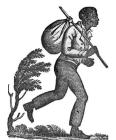 Credits:
Credits:Norval Johnson Heritage Centre
12
Historical RecordIn November 1775 Lord John Dunmore formed an all Coloured Corps. In exchange for military duty on the side of the British, Dunmore apparently offered to free any rebel owned slave.
Desperate, the Patriot side of the revolution had 200 Africans slaves enlisted with the 1st Rhode Island Regiment. The offer of freedom was withdrawn on June 10. No one will ever know if it was the result of too much opposition from property owners.
Early records Richard Pierpoint
According to "A Stolen Life" written by Meyler and Meyler, one refugee freedom seeker, Richard Pierpoint, appeared on the records at Fort Niagara serving under the British in 1780. Public records suggest Pierpoint was an escaped slave and joined Butler's Rangers where it can be assumed he participated in a number of raids across the American Frontier. Butler's Rangers were made up of British Loyalist and Aboriginal warriors who saw much action during the War of Independence and the War of 1812.
13
One of the few Coloured Corps plaques in the area20 July 2009
Niagara-on-the-Lake, Ontario, Canada
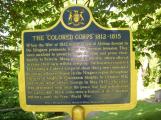 Credits:
Credits:James Black
14
How many Africans were fighting as Soldiers of the British in the War of 1812?The total number will never be known. But we do know that 19 Blacks sent a petition to Governor Simcoe asking for land. Their request, to have land segregated from the other citizens, received no reply from Governor Simcoe. The fact Pierpoint was assigned a piece of land in Grantham Township, the centre of present day St Catharines, suggests local authorities recognised his experience as a member of Butlers Rangers. In later years, Pierpoint was called Captain Dick because of his extensive service with Butlers Rangers and, later, during the War of 1812. The creek south of the Ojibwa trail that became St Paul Street in St Catharines was named in honour of Richard Pierpoint - hence, Dick Creek.
